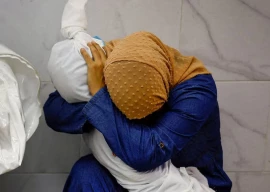
First, kudos to those who developed and executed the multiple security plans to prevent terrorist attacks on Youm-e-Ashur. A nerve-wracking task of herculean proportions, cover as it did several cities across the country and provided security to thousands of mourners in dense areas where preventing a single person from sneaking up to a crowd and mounting a suicide attack required meticulous planning and execution to a tee and more — much more.
Yet, there is deep irony in this success because despite the failure to kill, or perhaps simply due to the decision to remain hunkered down, the extremists won the day. This is the most important lesson of irregular war-fighting. The insurgent-terrorist wins even when he decides not to attack or even when he fails in his bid. Either way, he manages to increase horrendously the cost, direct and indirect, for the state.
Take two scenarios, using, first, a mythical central planning committee that coordinates the operations of multiple extremist groups. A pre-Youm-e-Ashur meeting examines the security plan of the state and a discussion ensues. One proposal is to try and breach through this security to show that even the best measures cannot prevent an attack; the other is to relax and let the state remain on high alert for two days. Let’s suppose there is a stalemate. A third proposal is presented which combines the two. Let’s send in some people; they can reconnoitre and see the degree of difficulty of mounting attacks. If an attack can be mounted, fine; if not, stand down.
The second scenario is that there is no central committee per se but the intent is known across the loosely-affiliated security groups. Each, in this case, has a high degree of operational independence. Each can decide on an independent course of action. Some, observing the security arrangements can decide to call off a possible strike; others can plan either for a dedicated strike or an opportunity target.
The one thing common in all this is that regardless of what the extremist groups can or cannot do — whether they decide to strike and fail; whether they decide not to strike at all — the state does not have the option to lower its guard. While Youm-i-Ashur would strain the state’s resources tremendously, even the normal, day-to-day functioning of the state now has to cater to the possibility of a surprise attack that can materialise any day, anytime, anywhere.
The cost to the other side is near nil, especially when it decides to not mount an attack. But even if it does, counting out the life of the man required to carry out the bombing, the suicide belt doesn’t cost more than $100-150. In case of a vehicle being used, if it’s not stolen, one can raise the cost of a mission to perhaps $4000. Compare this with the cost a state has to bear 24/7 to prevent just one such attack.
The armed forces, for instance, normally operate on a 33 per cent principle — at any given time, in theory, 33 per cent are deployed; 33 per cent are in the training cycle and 33 per cent are retrofitting and resting. This conflict has changed the percentages to 54 per cent deployment; 33 per cent training and 13 per cent resting/retrofitting. And while the resting/retrofitting percentage has gone down in favour of deployment, the nature of deployment itself requires that greater numbers should be resting, but they can’t. Additionally, even the 13 per cent supposedly resting in peace locations have to remain on high alert because the conflict has no real front and rear and the zones of war and peace are all mixed up. The police is worse off.
Take another example. With the entire Lahore police and other security forces deployed to prevent a terrorist attack, the criminals would have a field day. If the usual crime rate does not go up on any such day, it is pure luck. Add to this the cost of unattended emergencies and accidents etc and you get a picture of what is happening.
So far we have not monetised the costs; at least my inquiries in this regard have gone mostly unanswered. The direct costs are easier to calculate, the indirect more difficult. But the exercise is worth undertaking. What is clear, however, is that the cost will continue to rise until the mindset that desires to kill remains unchanged.
Published in The Express Tribune, December 20th, 2010.
































































COMMENTS (3)
Comments are moderated and generally will be posted if they are on-topic and not abusive.
For more information, please see our Comments FAQ